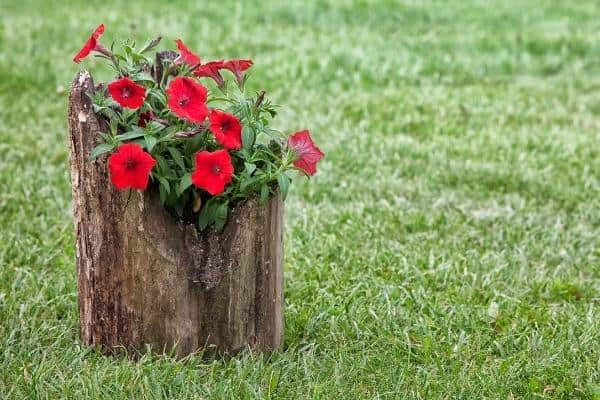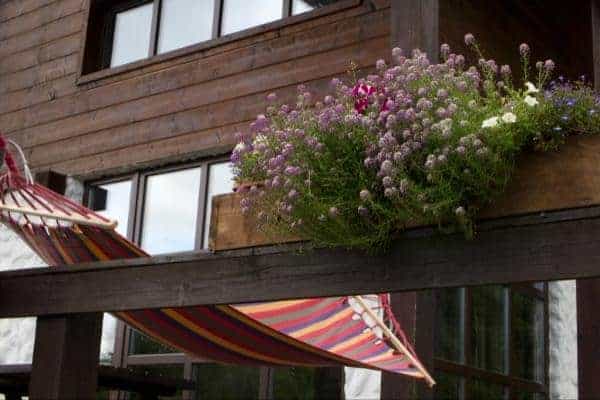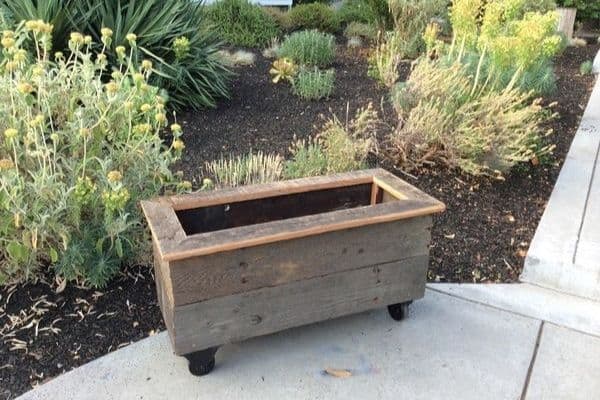Tony O’Neill, expert gardener and best-selling author of the famous “Simplify Vegetable Gardening,” “Composting Masterclass,” and “Your First Vegetable Garden,” combines lifelong passion and expert knowledge to simplify gardening. His mission? Helping you cultivate a thriving garden. More on Tony O’Neill
Planters offer an excellent alternative for creating a growth area for your plants. They are not just a coveted option for gardeners with restricted space, but also a popular choice among those with extensive lawns. Moreover, you have the option to build them yourself. However, are there any DIY planter boxes known to be superior?
Based on people’s preferences and requirements, the best DIY planter box can be different for everyone. For instance, someone with little space may like the idea of a tiered planter box, while an older person may want a planter with built-in benches.
So, to cater to your unique demands, we have curated many DIY planter box ideas. These planter boxes can help you keep your garden or patio a little more organized while offering a new and fresh look.
“I don’t think outside the box I think of what I can do with the box.”
– Henri Matisse

Bamboo Planter Box

While wood and clay are usually among the most common options for planters, these bamboo planter boxes will give your garden a rustic yet fresh look. Bamboo is also an excellent material fantastic used with wood that can help you make planter boxes with a retaining wall that will work perfectly well for your crawling plants.
Create a wood frame and decorate the box’s sides with bamboo twigs. This is a great way to use old wooden boards in your house. And then, if you wish, you can also build a retaining wall with tall stalks of bamboo.
Planter Box with Built-in Bench

If you like leisure time in your garden, this DIY planter idea will interest you. These are also great for older people as they make gardening more accessible by offering more accessible places to sit and rest.
However, you would want to invest in good hardwoods like cedar, redwood, or cypress. While these woods are much more long-lasting, they are also strong enough to be a good choice for benches.
Now, two standard styles of planter boxes feature a built-in chair. You can have benches surrounding the huge wooden planter box or a bench connecting two small planter boxes. You can pick the one that caters to your requirements the best.
Galvanized Tub Planter Box

Galvanized tub planter boxes are a fantastic option to bring character to your garden. You can easily find new galvanized tubs at hardware stores or feed stores. But to get a rustic, search vintage shops, flea markets, or garage sales.
To turn these tubs into planters, you can use garden landscape fabric to help create a barrier. This will not only keep the soil inside but will also allow proper water drainage. Then, you can add the soil and, finally, the plants. You can even paint the bright tub colors to give your garden a more vibrant look and feel.
Planter Box with Trellis

These planter boxes are great for someone yearning for privacy from those nosy neighbors. A planter with a trellis is one of the most elegant ways to add a privacy screen and some greenery to your yard. Your vining plants will love these planters.
Cedar is the best choice of wood for making trellis. However, any weather-resistant lumbar would work well. While building the planter can be pretty easy, some may find the trellis-making process tricky. But if you have the right tools and materials, you can complete it in just a few days.
Raised Planter Box with Drainage

We all know that the majority of plants do not like soggy soil. So, every garden bed should have proper drainage, even if raised garden beds are installed on hard surfaces. And incorporating a drainage system in your raised planter box can be easy.
There are two primary options that you can consider – drainage holes and an internal hidden drainage spout. Other than this, it should also be considered that raised planting beds do not entirely depend on drainage holes but also use their height (usually 11 and 12 inches) for adequate drainage.
Log Herb Planter

Making a log planter is one of the best ways to put a fallen tree to good use. (Hugelkultur is another!) Besides being extremely affordable and easy to make, log planters can add a touch of forest aesthetic to your garden.
For making a log planter, you would want to get softer wood, such as white pine, which will be easier to hollow out. Once all hollowed out, you will have a brand-new planter that you can use to plant invasive herbs like mint. You may even consider planting annuals and refilling the log yearly with new flowers or herbs.
Hanging Planter

Not just your garden, but these tiny hanging planters can brighten up any corner of your home. This is probably one DIY planter box idea that is highly versatile and has many variations. You can tie the planters up with a rope and hang on to the ceilings or build a wooden slab where your planters can sit.
You may also build big planter boxes that can be hung on the wall or fence. This is a great way to use some vertical space and greenery for tricky spaces in the house and garden.
Strawberry Towers

Are you tired of slugs’ strawberry harvest? These towers will keep them well above the ground and will thus reduce damage by those marauders. Also, it can help you ensure that these berry plants do not turn invasive with this tower-like container. And once it does get invasive, they do not tend to produce well. So, with this, you can be sure of getting fresh, ripe strawberries as June arrives.
To make a strawberry tower, four L-shaped frames to a center post and hardwood dowels must be made. Once you have the frame made, all you need to do is add a series of soil-retaining boards that are progressively smaller toward the top of the tower.
And if you are looking for a smaller and more affordable version, you can use up those buckets. Just punch in a few holes, and your strawberry tower will be ready.
Wicker Basket Planter

This is a fantastic way to put those picnic baskets to good use. Since there might not be a lot of space, depending on the basket size, you can consider planting annuals and succulents or creating a mini herb garden.
To convert your basket into a planter, begin lining the inner surface with heavy mil black plastic before putting a layer of pea gravel. This will help drainage, given that the basket has no drainage holes. Next, you can put potting mix with water retention beads.
This is a better option than the garden soil as it can be pretty heavy for your basket. Now, all you need to do is add your plants and relish!
Vintage Bathtub Planter

There is a huge possibility of having a used bathtub waiting to be turned into a beautiful planter. And even if you do not have one, you can quickly get one from a local junkyard or a thrift store. Besides being functional, it can be highly decorative and give your garden a rustic feel.
The chipped enamel and other imperfections add up to the charm.
There are a few perks of using an old bathtub as a planter. A bathtub already has a drainage hole and a slight slope towards that drainage hole, ensuring that the roots are not in the water for too long.
Repurposed Pallet Planter

Pallets are another resource that can be easily found. Moreover, they are highly affordable. And turning them into a planter is fun and easy. This is a great of creating a tiered structure and planting some small crops, herbs, or succulents.
Or you can turn it into a basic planter box and grow some medium-sized crops. Once done with all the drilling and hammering, you can line the box with landscaping fabric and begin planting. You may even paint the pallets to bring a pop of color to your garden.
You can even use these pallets as wood slabs for your tiny planters. Just hang it up on the wall or fence, and you are good to go.
Tire Planters

Another excellent material that you can use as planters is tires. Yes, you can upcycle and reuse tires completely newly by converting them into planters. Stack them up and fill potting soil before planting your favorite crops.
We would recommend you consider plants that are not so hardy. This is because rubber tires are great for insulating cool-weather crops and protecting them against root damage from frost. You can paint them vibrant and popping hues or leave them as is.
Living Wall

This is a fun and creative way of adding greenery to a garden without enough ground space. Although this is not precisely a planter box, a living wall is one of the best ways to use up some vertical space for growing plants.
This is perfect for growing air plants, succulents, or salad greens, as they do not take up a lot of space and can also be grown vertically. There are some fantastic plant options you can consider for your living wall.
While placing plants on your living wall, group them vertically or angled drifts, not horizontally. This will ensure that the tall plants are not located on the higher rows and prevent the plants below from getting enough sunshine. Once you know, that is not an issue, and you can pick any pattern you wish for your living wall.
Planter Box with a Pond

Every gardener yearns for an in-ground water feature in their yard. But only some have the space for it. But this planter box with a pond will help you build a miniature aquatic haven and encourage wildlife in your garden. And the best part is that this tiny pond can fit anywhere you want – balcony, deck, or patio!
All you need is a planter frame with different sections. A ratio of one-third planter and two-thirds pond is good. Now, install a plastic liner or use a water sealant on the inside of the pond frame, while on the planter side, you need to drill some holes for drainage. Add some plants and fish, and you are done.
But if you have the space to build an in-ground pond, I have a video about step by step guide to building a wildlife pond. You can watch it below.
15. Deck Rail Planter Box

A rail planter box will be perfect for your deck outside the kitchen. You can grow herbs in it and use them fresh while cooking. These will also sit elegantly on your patio and porch and offer instant curb appeal.
All you need to do is build a basic window planter box will drainage holes. Ensure the side braces are cut at a 15-degree angle on both ends. You must create a bottom brace to support amounts and help it snuggly hold onto the railing.
Self-Watering Planter Boxes

You would need a perforated drain pipe to help store and distribute water. This will work along with a fabric sleeve that will be placed at the bottom of the box. So, here is how this works.
Once you fill the drainpipe reservoirs, they will allow the air to circulate; thus, the water will draw towards the roots of the plants whenever they require it. One of the most notable benefits is that plants are watered from below.
This ensures that roots are consistently moist as there is less evaporation. Thus, you do not have to water as often.
If gardeners talk about convenience, they are probably thinking about self-watering planters! Although they might take a little effort, they will save you time and offer easy maintenance in the long run.
Window Planter

Window planters are similar to deck rail planters but much easier to make. Building the bottom brace but only the basic planter box would be best. However, it would be best if you considered creating cleats. One of the best ways to mount the planter and secure it to the exterior wall is through cleats.
This will give it more critical support since the planter may get heavy when filled with soil and plants. I am sure a window planter will be both – a decorative and functional addition to your house.
Greenhouse Planter Box

A greenhouse planter box is necessary for gardeners who wish to grow crops even in winter. Plants can thrive in the growing conditions offered by a greenhouse. And you can create a mini greenhouse in a planter box with ease.
All you need is a planter box; for the greenhouse structure, you would need three wood boards and three coat hangers. Once you straighten them out, you will get wires perfect for giving your greenhouse that loop-like structure while the wood offers support.
Measure the wires and cut a plastic sheet to cover the structure. You would not have a simple and small greenhouse that will benefit your plants enormously.
Suppose you want to build a mini greenhouse made out of plastic. I have an article about the mini greenhouse. You can read it here.
Tiered Planter Box

Resembling steps or those magazine holders found in offices, these tiered planter boxes are something one should consider. The planters usually appear to cascade from back to front and are great for growing herbs and small plants.
Apart from building the planter boxes with a rot-resistant lumbar, you can consider lining them up with regular planters to extend the life of the wood planters. You need to create a structure with three slabs to create the tiers on which the planters will sit.
Begin with making two A-shaped ladder-like structures. Once you have them, join them using a wooden slab from the bottom. You would now have a design allowingsystemanters to rest on it.
Place your planters, add soil and plants, and you are done!
Rolling Planter Box

Adding wheels to almost anything is a fantastic idea. And while planter boxes work great with wheels, they get better. It is a mini garden on wheels, and I am sure you want to make your own.
It would be best to have swivel casters, a heavy-duty metal wheel, and enough wood boards to build a planter box. Once you have built your planter, you must place four wooden boards on each inner corner of the box. Turn the box over and drill four holes for your swivel casters.
Depending on the size of your planter, you can install four or six wheels. Once done, you can line the planter and add soil and plants!
FAQs on 20 Best DIY Planter Boxes You Can Make Now!
Is it cheaper to build your planter box?
Building raised planter boxes is simple and usually less expensive than buying them.
How deep should planter boxes be?
In most cases, eight to twelve inches is sufficient. The bed could be taller and filled with a porous growing medium if drainage is an issue or the plants you’re planting demand drier soil. The depth of the vegetable beds should be 12 to 18 inches.
What do you put in the bottom of a wooden planter?
Cover the entire bottom of the pot with a layer of plastic or metal screen cloth to keep drainage holes open. Alternatively, cover the gaps with shards of broken flowerpots or other ceramics.
Conclusion on 20 best DIY planter boxes you can make now
I am sure at least one of these fantastic DIY planter box designs will interest you. So, are you all set to create fun and unique planter boxes?
If you found value in this article, subscribe to the blog for all future updates. You can do that below.
